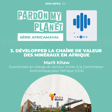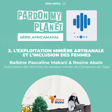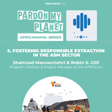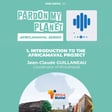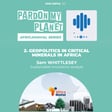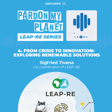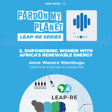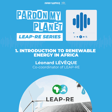Become a Creator today!Start creating today - Share your story with the world!
Start for free
00:00:00
00:00:01

Adapting to climate challenges: insights from Mozambique's farmers
In this episode of Pardon My Planet, we explore how climate services, genetic research, and collaboration with local farmers are helping communities in Mozambique adapt to climate change.
Our guests, Valentina D’Amico, a socio-economic researcher, and Marta Da Graca Eugenio Solemanegy, a Mozambican PhD student specialising in agronomy and genetics, share their on-the-ground experiences. They discuss the challenges faced by farmers, from limited access to climate information to the need for better crop varieties, and explain how tailored climate services are shaping a more resilient future.
More information on: lgi.earth/podcast
Transcript
Introduction to Climate Services and Adaptation
00:00:09
Speaker
Hello and welcome to Pardon My Planet podcast. I'm Anshalot, your host, and today we'll explore how climate services, genetic research and collaboration with local farmers are helping communities adapt to climate change and build resilience.
Case Study: Mozambique and the Focus Africa Project
00:00:24
Speaker
In this episode, we'll dive into a fascinating case study from Mozambique, a case study part of Focus Africa, a European Union-funded project that develops sustainable and tailored climate services across southern Africa, including Mauritius, South Africa, Malawi, Tanzania, and Mozambique.
Meet the Guests: Valentina and Marta
00:00:42
Speaker
Joining us are Valentina Damico, a social economist researcher, specialized in participatory methods in farming systems, and Marta Soleimaneji, a PhD student from Mozambique who brings expertise in agronomy, genetics, and local farming systems.
00:00:59
Speaker
Together, they've been working closely with local farmers, combining scientific insights with underground experience to develop innovative solutions like climate-ready crop varieties and tools to improve agricultural resilience.
Challenges for Mozambique Farmers: Climate Vulnerability
00:01:14
Speaker
Hello, Valentina and hello, Marta.
00:01:17
Speaker
I shall not moaning. Hi. Valentina, can you start by explaining the general context of the farming systems in Mozambique and the challenges farmers face when it comes to adapting to climate change?
00:01:32
Speaker
Sure. So our case studies was developed in the north of Mozambique, in the Nampula province, specifically in the district of Mughuola. So why this district? First of all, this is a district where the agriculture is strongly important, of course. We talk about subsistence agriculture. So farmers rely on agriculture for their consumption, for their subsistence and in general. So it's also true that this in this area, they face a strong climate vulnerability. So we interacted with them, ah with the farmers at the beginning of the process the project, especially when we tried to do a background analysis and we realized that it's
00:02:14
Speaker
they perceive the climate change, 85% of them perceive the climate change, effort and perceive that the climate change affected production, copy, and rice. They gave us very specific examples. For example, the most important issue for them is the ah is is that the Renaissance and has become ah more unpredictable um and variable. So this is a very crucial point because the agricultural activities start with the rainy season, so the fact that they are not able to predict the start might affect their production.
00:02:56
Speaker
So, if um if the rain arrives late, for example, and short and the rainy season is short, that means that they probably should use a short cycle variety, for example, or they should make these kinds of decisions, but they are not able to do ah to to make this decision because because they don't know ah what characteristics.
00:03:21
Speaker
ah what would be the characteristics of their coming rainy season?
Developing Climate-Ready Solutions
00:03:24
Speaker
I guess also they were able before to predict because of their expertise in you know ah their the their field and in ah knowing when the reason rainy season is coming, everything is ah ah disturbed, let's say, by ah climate change. This is where the climate services that you try to provide also come into play, right?
00:03:45
Speaker
Exactly. so In the past, but still in the present, I would say, ah there is so there was and there is a strong use of traditional knowledge. The traditional knowledge is very important in this context because of course it's based on this peak experience. so It's an empirical knowledge not that we but we to to which we give a lot of ah value. ah The problem is that with the climate change, these ah this started to prove less effective. so Looking, for example, at the migration of specific births or looking at the and at the tree losing the leaves and so on before was effective. But now with the climate change and the stream events, these signals are not proving effective always.
00:04:32
Speaker
So it's important for them to integrate um this kind of knowledge, which we still consider very important, but with some formal knowledge to overcome the uncertainty coming from the grammar change.
00:04:48
Speaker
So this is the reason why we try to focus in this specific project on two climate services. First, varieties, cowpea and indentification, or cowpea and resprieties, with potential for resilience to the climate change. That means resilience, for example, to the different characteristics of the rainy season. Now the rainy season can be late, early, short, long, or there might be extremes like flooding or cyclones and so on. Of course, we cannot cover everything, but what we identified are the most important issues that they face. The second um climate service is the forecast, because of course you have a portfolio of varieties that might use in the different conditions, but it's important for you to know which are the conditions of the upcoming rain season. of course so
00:05:39
Speaker
they don't have access to the climatic information.
Participatory Approaches in Agronomy
00:05:43
Speaker
We hope that that in the near future they will have access to the climatic information to know what to expect ah from the rainy season and then being able through the portfolio varieties to use the one that better suits the characteristic of that And needs to have all this knowledge and to make sure that also what you are providing is suited to their needs, ah you've both been recently part of a field mission in Mozambique. Marta, can you share some insights into the tools and approaches you've used to engage with local farmers and explain also what role does genetic research play in this work? Talking about food security and climate change of vulnerability,
00:06:29
Speaker
These are very complex issues that cannot be addressed just using a single approach. So basically in this case that we try to implement a math level approach, combining agronomic approach, combining genetics, combining socio-economic approach, and also a climatic approach. So let me start by saying that From very beginning, we we use the participatory approach, engaging with the farmers, with this community, trying to understand their needs, first of all, because there is a cultural, there is a tradition that we always have to to follow. Of course, we want to understand, we want to address the issue, but we always have to try to make sure that
00:07:24
Speaker
We understand, first of all, their are problem before bringing solutions to them. Right. So by doing this. participatory approach, we try to work with them, understanding which type of cowpea they are producing, which of the varieties they have there, trying to understand, first of all, the diversity, how cowpea is important for them. Is there any other beneficial they are getting from this? Is it just for consumption purpose or is there any other? that
00:08:00
Speaker
benefit they are getting from it. But of course, there is no improvement without genetics. So if we want to be able to have better varieties to respond for this climate challenge, we need to integrat we need to integrate genetics, understanding the genetic background of this material so that we'll be able to deliver to the farmers what they really need to make sure that genotypes that we'll be selecting. I'm seeing genotypes, but I'm talking about the variety. It corresponds to what farmers need and also for the climate challenge. Also, Valentina, from a socio-economic perspective, how are farmers responding to these tools, these collaborations? ah Do you have any ah stories or trends that stood out during this field trip?
00:08:58
Speaker
I think that farmers responded very well to the work that we did because they were involved ah from the beginning. So every step was shared with the farmer and we get an assessment from them. That means that, for example, as Marta was mentioning, ah we had experimental field in which we showed them the 350 genotypes, so they assessed just these genotypes, and we understood what characteristics are very interesting for them, because there is no innovation without an assessment of their preferences. We can provide the most the most resilient variety to specific climatic conditions, but if these varieties
00:09:43
Speaker
do not match ah their consumption preferences, for example. And this is very true in this context. For sure, they won't use them. So ah they were involved in the experimental fields. We understood ah the traits and characteristics that they prefer.
The Role of Cowpea in Food Security
00:10:00
Speaker
And um together with the results from the genetic analysis and then chromatic analysis, we were able to narrow down the selection from 350 to 6.
00:10:11
Speaker
that we ah eventually assessed in the communities ah during the last focus group discussion that we had and that was a very interesting experience because we realized that even considering their preferences and doing the assessment in two different villages but close villages so ah we were expecting the same results.
00:10:35
Speaker
And that was not true because, for example, and next something that really and surprised us is that in one village, for example, they loved the red color of the seeds because they associate associate these characteristics, um content of vitamins, and they like the color in the local carrille, which is a traditional dish that they do.
00:10:59
Speaker
And in the other village, which is a very ah close village, ah they in in the assessment, this was the less preferred variety because of the color. So this is very important for us and the on take-home message here is that when you work in the breeding, ah you cannot never work on a specific variety, but you also always need to consider a portfolio of varieties that can accommodate the different preferences of farmers. And Marta, can you explain maybe a bit more in de detail the work that you've been doing with farmers on ah so the rice and bean varieties? Why are these crops so important for this region and also what are the expected impacts on climate resilience? Along starting by telling you that we are talking about cowpea, which is a little womb,
00:11:57
Speaker
This is very resilient crop and very important crop for the small older farmers in Mozambique because it's a crop in which when we are talking about food security in terms of rank in Mozambique is in the fourth position. This means that from this crop farmers are able to not just farmers But the I would say that 80% of the people that work in agriculture make benefit of it. Because from this, everything from this crop is useful. Starting from the leaves, starting from the pots, starting from the seeds. And you can still use the left of the field to feed our animals. Yes, it's very complete. from
00:12:48
Speaker
Unfortunately, with climate change now, the agricultural sector is very affected. And we do have a lot of diversity of cowpeas. As Valentina explained before, we could see that there is a prefer there is um specific preference for different regions. This means that we have to look for the variety of portfo or variety of the diverse that is there and to try to make use to respond to this challenge that we are facing, which is climate variability.
Food Security and Farmer Decision-Making
00:13:24
Speaker
but When you were mentioning the 350 varieties that you found, that it does it mean that you went from village to village to find and see if there were varieties or where where those 350 varieties come from? Okay, so let me start by saying that there is a national gene bank
00:13:46
Speaker
in which as has collected these seed samples. So there are 350 samples. They represent different regions in Mozambique. But because we were interested on seed, how diverse these materials are, Mozambique makes water with five countries.
00:14:09
Speaker
So we we wanted to see is the cowpea that's coming from Mozambique different from the cowpea in the neighboring countries. What can we use from the neighboring countries to make this crop more strong in terms of resilience? So what we did we was also trying to collect some samples from the neighboring countries such as Malawi,
00:14:32
Speaker
Tanzania, South Africa, Zimbabwe. So we got some samples and we put them, because sometimes the farmer may be, they may not know the name, but they may know them by seeing them in the field.
00:14:48
Speaker
So this is where we got these 350 samples. When you were mentioning, for example, the color ah red that was associated, for example, to ah ah to food, to vitamins, to something healthy, was there also, I guess, this whole discussion about maybe what appear to be the best choice and what could be the most adapted also to the to their field, how this this this discussion happened?
00:15:15
Speaker
So one of the objectives of the project was specifically to understand farmers decision making. In this area of Mozambique, ah the decision making is very rigid. What we realized is that the this is a two-step process. So in the first step, farmers,
00:15:34
Speaker
they do not make a real decision because the problem that they face when the rainy season starts, which is in October, is that in a few months, they won't have any food availability. So February is the most critical month. So when October arrives and the rain should not survive, but it doesn't, for example, there is a strong problem because if they cannot start the production, ah that means that they will be suffering in February. So at this point, that decision is to plant the
00:16:10
Speaker
only short cycle variety that they have, even if it's not the preferred one. So for the first part of the season, they use this short cycle variety. When it comes to February, March, they start a new cycle in which they try to use the varieties that they like the most to fulfill their consumption preferences. And of course, they are very different.
00:16:34
Speaker
They are very different and this is when I mentioned the red variety. This is a variety that they don't use at the beginning of the season but they use it later because ah it's a long cycle variety and and and they use it and then as in the second part of the productive season. so In this sense, what we understood is that for the first part of the season, it's important to find and provide varieties that can overcome the... they yeah Exactly. And then of course, the real decision of their preferences comes later.
00:17:15
Speaker
Exactly, because then yeah we are talking about climate resilience and adaptation, but there is, of course, the more urgent issue of ah food security and security needs now.
Strategies for Long-Term Resilience and Collaboration
00:17:29
Speaker
So how can also you have this conversation of selecting, let's say, the right crops that in maybe the long term will be more advantageous to them when you have this type of urgent need that needs to be addressed now? How do you take all of this into account to make sure that so in, let's say, in the long term, they they don't lose in the end something that is ah valuable?
00:17:53
Speaker
i'm am In this sense, I think that most the the most important contribution came from the partners because we realized that the decision-making was strongly affected by the food security. This is always true, but in this case, it's the most important driver of the of the decision.
00:18:18
Speaker
So we had a conversation with the and extension people in the district, so ah in the district and in the province. So we showed the result ah during the last mission. And I agree that this decision making is so rigid because of the security. So when we discussed the strategies, we realized that probably we should consider different strategies for different farmers. That means that farmers that face strong food insecurity issues um cannot be expected to adopt something new because their decision and because they their subsistence is connected to their decision. So for this farmers, if we want them to consider different varieties, we need to work with them in field. That means ah trying to um overcome this ah lack of trust
00:19:16
Speaker
which I wouldn't call it la lack lack of trust or risk aversion. It's easy to say risk aversion, but if your life depends on what you cultivate and your willingness to change is very low. This is yeah this so absolutely right. so If we want to to to work with these farmers, we need to consider longer processes.
00:19:39
Speaker
and field work with them. That means like, for example, um creating field ah some experimental field in the communities. So some displays so they can see how the varieties perform and they can understand if they want to ah to use these varieties, what they like, if they like the production and so on, if they trust. It's a matter of trust because the risk of losing the harvest has incredible consequences on their life. So this is for the farmers that of course are
00:20:10
Speaker
ah more impacted body by the food insecurity. And then for the other farmers, maybe there might be other intervention. Also something that should be considered is to start working on a nutritional value of these crops, of these varieties. This is mid-term, long-term objectives? Yes.
00:20:32
Speaker
Yes, I think that this is the, and and also this is what we, did the strategies that we identified with the local stakeholders, especially in the district, especially the province. So, and also with the local extensionists, because what happened is that we worked since the beginning with the field extensionists and they work with us ah because they know the community and they know the local specificity.
00:20:59
Speaker
of these practices in each community. So we were able to work with them and to identify the gaps and also the future strategies and that was very useful. So there was really a mutual learning and we we would like also to take this no occasion to to say thanks to them because they were so important in this process.
00:21:25
Speaker
Well, thank you Valentina and Marta for joining us in this conversation.
Episode Conclusion and Further Resources
00:21:30
Speaker
And to our listeners, you can find all the information about the episodes and all the episodes of Pardon My Planet at lgi dot.earth slash podcast. You can also listen to the episodes on Spotify and Apple Podcast. Until next time, bye-bye.
